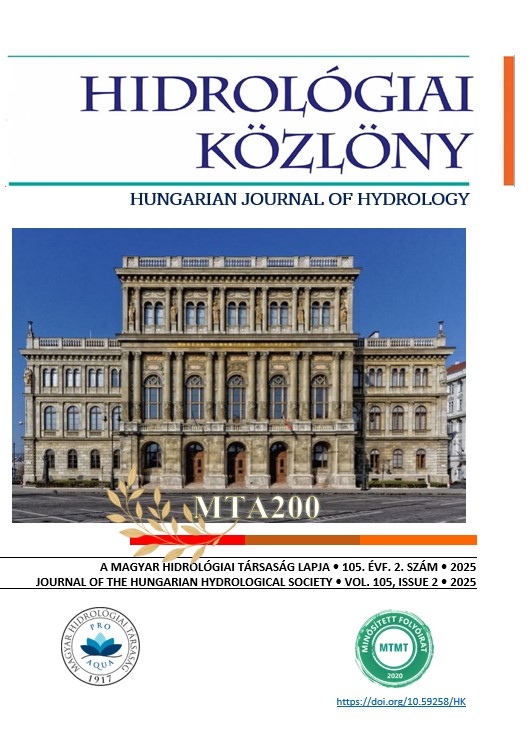Öntözővíz-tározási lehetőségek vizsgálata Békés-Rosszerdő területén
Absztrakt
A klímaváltozás kedvezőtlen hatásai és kockázatai hazánk mezőgazdaságára is jelentős hatással vannak és a tapasztalatok azt mutatják, hogy az évek múlásával egyre súlyosabb helyzetekkel fogunk találkozni. A meteorológiai statisztikák alapján megállapítható, hogy Magyarországon az éves átlagos hőmérsékleti értékek emelkedő tendenciát mutatnak, ezen belül a nyári hónapok átlagos hőmérséklete kiemelkedő mértékben növekszik. A lehulló csapadékok éves átlagos mennyisége ezzel szemben „csak” enyhén csökken, de annak területi és időbeli eloszlása hazánk egyes területein jelentős eltolódást mutat.
A Körösök-völgye mezőgazdasági értelemben igen sajátságos, kettős helyzetben van: hazánk legértékesebb termőterületei közül sok ezen a környéken található, de az egykori folyószabályozási munkálatok hozadékaként a területek zöme belvízképződésre hajlamos. Ezeken kívül jelentős hazánk kitettsége a felvízi országok vízgazdálkodással kapcsolatos döntéseinek. Mindezen kockázatok miatt a mezőgazdasági öntözés fontossága az idő múlásával egyre inkább felértékelődik, és manapság egyre szélesebb körben elterjedt az a nézet, hogy ha valaki megtérülő módon akar gazdálkodni, annak öntöznie kell.
Magyarországon az egyik meghatározó fejlesztési irányvonal jelenleg is a vízvisszatartás lehetőségeinek felkutatása: az utóbbi évtizedekben jelentős mértékben nőttek a különböző célú tározók száma, melyek célja a lehulló vízmennyiségek tározása és a szükséges időben történő felhasználása. Ennek megfelelően azt a célt tűztük ki magunknak, hogy a környezetünkben olyan vízvisszatartásra alkalmas helyet találjunk, mely alkalmas lehet öntözővíz időszakos tározására.
Az általunk vizsgált terület Békés-Rosszerdő térségében helyezkedik el. A terület geodéziai felmérése után 3D terepmodellt alkotottunk, majd meghatároztuk a tározó főbb paramétereit. Ezt követően HEC-RAS 6.6 programmal modellt készítettünk a tározó feltöltéséről és megállapítottuk, hogy a várható feltöltési idő az V. Vargahosszai-főcsatorna maximális öntözési üzemi vízszintjét figyelembe véve mintegy 19 nap. Ezután tételes költségbecslést készítettünk a várható kivitelezési munkákra, ahol figyelembe vettünk minden nemű várható költséget (előkészítési munkák, tervezés, engedélyeztetés, építés stb.).
Hivatkozások
AKI (2023a). A mezőgazdasági kockázatkezelési rendszer működésének értékelése 2022, Agrárközgazdasági Intézet, p. 119. https://www.aki.gov.hu/termek/a-mezogazdasagi-kockazatkezelesi-rendszer-mukodesenek-ertekelese-2022/ ISSN 2786-3247 (Online) (Letöltve: 2024. 10.02.)
AKI (2023b). Statisztikai jelentések – Öntözésjelentés 2022. év, Agrárközgazdasági Intézet, XXVI. évf., 1. szám, p. 22. https://www.aki.gov.hu/termek/ontozesjelentes-2022-ev (Letöltve: 2024. 07. 17.)
Barker, L.J., Hannaford, J., Magee, E., Terner, S., Sefton, C., Parry, S., Evans, J., Szczykulska, M., Haxton, T. (2024). An appraisal of the severity of the 2022 drought and its impacts. Hydrology and Earth System Sciences, Volume 79, Issue 7. https://doi.org/10.1002/wea.4531
Biavetti, I., Mulhem, G. (2022). Crop monitoring in Europe September 2022 – Rain arrived too late for summer crops – Yield forecasts further reduced. https://publications.jrc.ec.europa.eu/repository/handle/JRC127965 (Letöltve: 2024. 08. 07.)
Brouwer, C., Heibloem, M. (1986). Irrigation water needs, https://www.fao.org/4/s2022e/s2022e07.htm. (Letöltve: 2024. 07. 17.)
Dunka S., Fejér L., Papp F. (2003). A Közép-Tiszántúl vízi története. Vízügyi Múzeum, Levéltár és Könyvgyűjtemény Budapest, p. 210. ISBN 963-212-280-1
ECMWF (2023). European Centre for Medium-Range Weather Forecasts, European climate marked by heat and drought in 2022 – report https://www.ecmwf.int/en/about/media-centre/news/2023/european-climate-marked-heat-and-drought-2022-report (Letöltve: 2024. 08. 07.)
EOTR (1973). Egységes Országos Térképrendszer 1:10 000 méretarányú térképsorozat (1973). https://geoshop.hu/
E-KÖZMŰ (2025). www.ekozmu.e-epites.hu (Letöltve: 2025. 04. 23.)
Fejér L. (2010). A vízitársulatok 200 éve. Vízgazdálkodási Társulatok Országos Szövetsége Budapest, p. 260. ISBN 978-963-06-9370-7
Garrido-Perez, J.M., Vicente-Serrano, S.M., Barriopedro, D., García-Herrera, R., Trigo, R., Beguería, S. (2024). Examining the outstanding Euro-Mediterranean drought of 2021–2022 and its historical context Journal of Hydrology, vol. 630, February 2024, https://doi.org/10.1016/j.jhydrol.2024.130653 (Letöltve: 2024. 07. 11.)
HEC-RAS (2024). HEC-RAS 6.6 Guides and Tutorials, https://www.hec.usace.army.mil/confluence/rasdocs/hgt/latest/guides (Letöltve: 2024. 10. 16.)
Jogtár (2004). 196/2004. (VI. 21.) Korm. rendelet a Magyar Köztársaság Kormánya és Románia Kormánya között a határvizek védelme és fenntartható hasznosítása céljából folytatandó együttműködésről szóló Egyezmény kihirdetéséről https://net.jogtar.hu/jogszabaly?docid=a0400196.kor (Letöltve: 2024. 10. 14.)
Kozák P., Fiala K., Benyhe B., Fehérváry I. (2022). Az aszály monitoring hálózat és az aszálykezelés gyakorlata a 2022. évi aszály tükrében. Vízügyi Közlemények 2022. 104. évf. 3. sz. pp. 113-131.
KÖVIZIG (2020). Körös-vidéki Vízügyi Igazgatóság Általános Belvízvédelmi terve és mellékletei.
MET (2024). Magyarország éghajlata - éghajlati visszatekintő. https://www.met.hu/eghajlat/magyarorszag_eghajlata/eghajlati_visszatekinto/elmult_honapok_idojarasa/ (Letöltve: 2024. 10. 02.)
NATURA 2000 (2024). Natura 2000 Network https://natura2000.eea.europa.eu/ (Letöltve: 2024.10.14.)
Marton A. (2023). A 2022. év időjárása. Légkör, 68. évf. 2. szám, pp. 102-109. https://epa.oszk.hu/03900/03956/00071/pdf/EPA03956_legkor_2023_2_102-109.pdf (Letöltve: 2024. 07. 17.)
OVF (2022). Magyarország vízgyűjtő-gazdálkodási tervének második felülvizsgálata – Magyarország vízgyűjtő-gazdálkodási terve 2021. Budapest, p. 712.. https://vizeink.hu/vizgyujto-gazdalkodasi-terv-2019-2021/vgt3-elfogadott/ (Letöltve: 2024. 03. 20.)
Ramsar Convention (2024). The Convention Of Wetlands https://www.ramsar.org/ (Letöltve: 2024. 10. 14.)
Copyright (c) 2025 Attila Nagy, Ádám Luczó

This work is licensed under a Creative Commons Attribution-NonCommercial-ShareAlike 4.0 International License.




